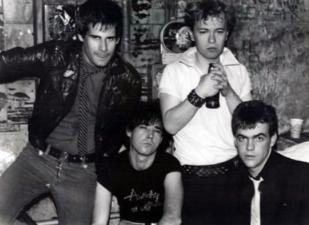“You have to picture a completely different Toronto. A Queen Street where there was no people,” Ralph Alfonso says, pointing to the bustle of Saturday shoppers walking along Queen and John streets, a lineup for Starbucks coffee snaking behind him.
“In 1976, Queen Street was used bookstores, mom-and-pop clothing shops . . . This was a forgotten street; this was not a cool street.”
Alfonso is setting the scene for when and where the city’s punk culture was born: Peter Pan restaurant was a hipster hangout with cheap food; the Horseshoe was a country bar; Yonge St was where it was at.
Queen sat mostly quiet, but not for long.
The British press was noticing punk rock pioneers out of New York like Patti Smith, and soon, the now-iconic bands were hitting the road.
In the fall of 1976, the Ramones played Toronto’s New York Theatre and “ignited the flame,” Alfonso remembers. “Everybody that was in that audience started a band the next day.”
It’s a part of Canadian music history that often gets passed over, Alfonso says, in favour of our rock ’n’ roll or folk past.
But within its history is an even lesser-known story — it was Toronto’s queer community that gave shelter to the punk scene while it was in its infancy, allowing it to grow up to be the short-haired, leather-jacketed, glam rocker it wanted to be.
“We had more in common than you think,” Alfonso says. “You’ve got two marginalized communities — you’ve got the punk scene, which is youngish, different, a target for violence. And you’ve got the queer community that’s a bit more established and a bit more organized in terms of safe havens.”
Alfonso is looking back this week on the era when “circumstances made strange bedfellows,” as one of the key bands from the time, the Diodes, is reuniting for a brief Ontario tour. Their reunion includes a stop at Toronto’s Horseshoe Tavern on Nov 17.
Before the show, Alfonso is offering a walking tour of the old neighbourhood haunts. One of the most important landmarks will be the Crash ‘n’ Burn club — a space offered up by the queer-centric arts collective, the Centre for Experimental Art and Communication (CEAC).
“CEAC saw an opportunity to help foster this scene and help promote it because they saw what it was,” says Alfonso, who would go on to manage the basement club, south of Queen and Duncan streets.
“The queer arts community found a kinship with these bands, this new ethos that was happening, because it was this weird, worldwide thing. You knew something was changing,” he says. “There was this freedom that was about to happen
. . . It was like ‘Okay, so I can’t play your club? Well screw you, I’ll start my own club . . . I can’t wear a garbage bag as a dress? But I am! What are you going to do?’ ”
The two scenes often overlapped. It is hard to speak of Toronto’s early punk scene without mentioning Carole Pope and Rough Trade, whose style paved the way for teenaged rebels and sexual adventurers across the GTA.
Alfonso reminds that the link between the two communities goes beyond Toronto or the Crash ‘n’ Burn club, which fizzled after just a few intense months of partying in 1977.
“The original New York punk scene, like the Ramones and all that, a lot of that was almost outright borrowed from queer culture at that time. The uniform, the jeans and the leather jacket,” Alfonso says. “A lot of punk fans didn’t know that.”
The Deets:
The Diodes
Thurs, Nov 17
9pm – Dildoniks
10pm – Dentata
11pm – Diodes
With guests Dentata and Dildoniks
Horseshoe Tavern
Tickets: $15 advance
The Punk Tour of Queen St
Starts at OCAD at 2pm
Email: ralph@bongobeat.com
Other Ontario dates:
Nov 15 – Waterloo – Starlight Club
Nov 18 – London, Call the Office
Nov 19 – Hamilton, This Ain’t Hollywood (presented by the Hamilton Music Awards)

 Why you can trust Xtra
Why you can trust Xtra


